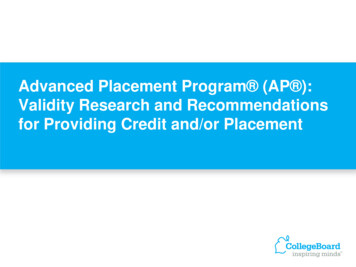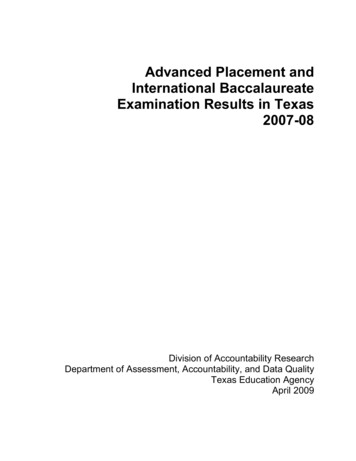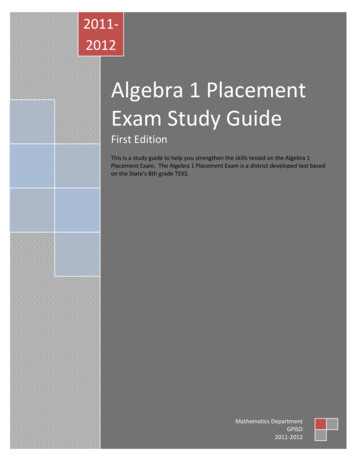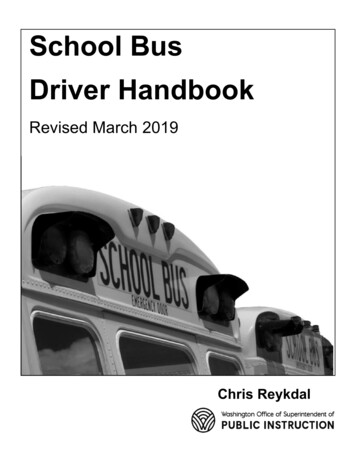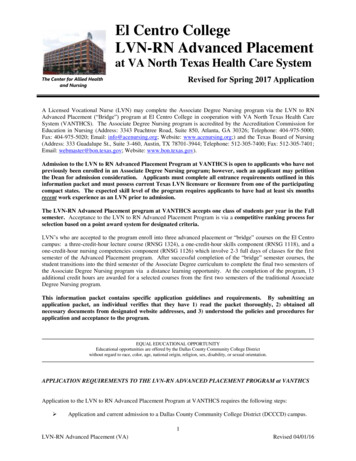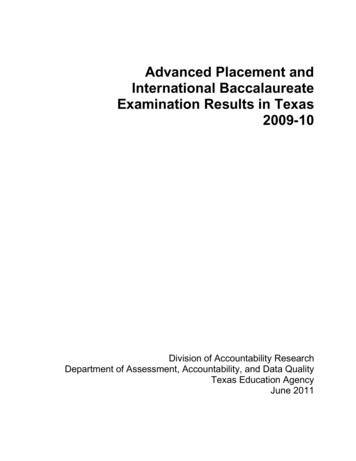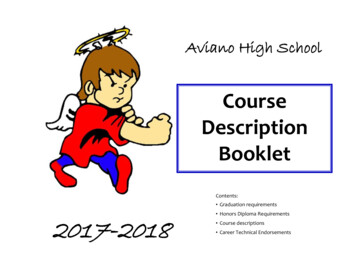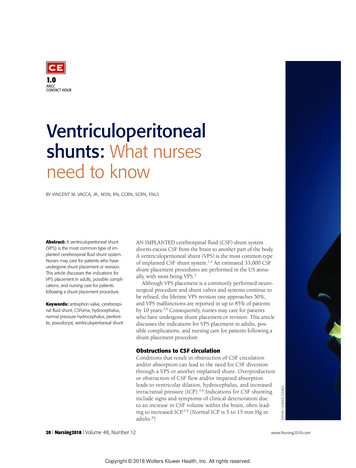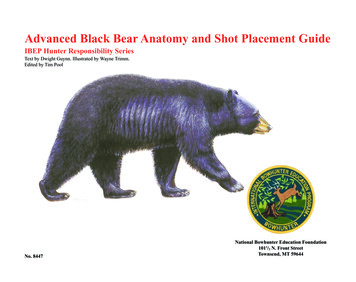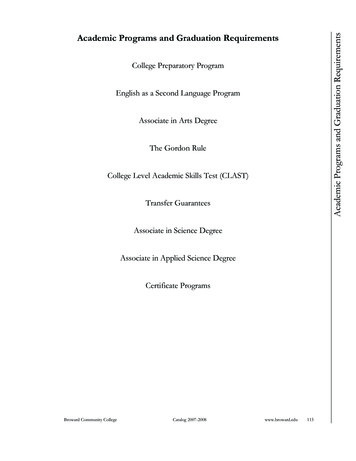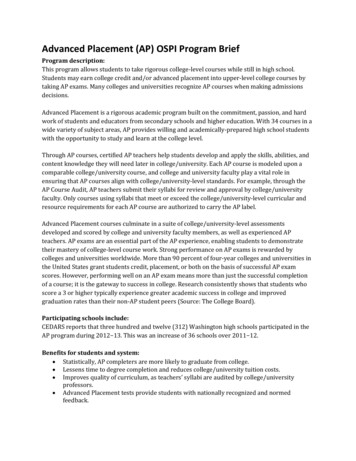
Transcription
Advanced Placement (AP) OSPI Program BriefProgram description:This program allows students to take rigorous college-level courses while still in high school.Students may earn college credit and/or advanced placement into upper-level college courses bytaking AP exams. Many colleges and universities recognize AP courses when making admissionsdecisions.Advanced Placement is a rigorous academic program built on the commitment, passion, and hardwork of students and educators from secondary schools and higher education. With 34 courses in awide variety of subject areas, AP provides willing and academically-prepared high school studentswith the opportunity to study and learn at the college level.Through AP courses, certified AP teachers help students develop and apply the skills, abilities, andcontent knowledge they will need later in college/university. Each AP course is modeled upon acomparable college/university course, and college and university faculty play a vital role inensuring that AP courses align with college/university-level standards. For example, through theAP Course Audit, AP teachers submit their syllabi for review and approval by college/universityfaculty. Only courses using syllabi that meet or exceed the college/university-level curricular andresource requirements for each AP course are authorized to carry the AP label.Advanced Placement courses culminate in a suite of college/university-level assessmentsdeveloped and scored by college and university faculty members, as well as experienced APteachers. AP exams are an essential part of the AP experience, enabling students to demonstratetheir mastery of college-level course work. Strong performance on AP exams is rewarded bycolleges and universities worldwide. More than 90 percent of four-year colleges and universities inthe United States grant students credit, placement, or both on the basis of successful AP examscores. However, performing well on an AP exam means more than just the successful completionof a course; it is the gateway to success in college. Research consistently shows that students whoscore a 3 or higher typically experience greater academic success in college and improvedgraduation rates than their non-AP student peers (Source: The College Board).Participating schools include:CEDARS reports that three hundred and twelve (312) Washington high schools participated in theAP program during 2012 13. This was an increase of 36 schools over 2011 12.Benefits for students and system: Statistically, AP completers are more likely to graduate from college. Lessens time to degree completion and reduces college/university tuition costs. Improves quality of curriculum, as teachers’ syllabi are audited by college/universityprofessors. Advanced Placement tests provide students with nationally recognized and normedfeedback.
Provides students a chance to try college/university-level coursework while still in highschool with teacher and parent support.Student responsibilities: Students must be willing to undertake the challenge of difficult work. Students will be graded as though they are in a college/university course. Students may take the AP exam in May.Cost(s) to students:OSPI has participated in the federal AP Test Fee Program grant since 1999. Through this program,test fees are reduced for qualifying low-income students eligible for AP testing offered through theCollege Board and the International Baccalaureate Organization (IBO). This opportunity is fundedthrough the federal AP Test Fee Payment Program for low-income students. This program isauthorized by the Elementary and Secondary Education Act, Title I Part G.Advanced Placement reimbursements are paid directly to the College Board rather than throughgrants to public or private schools. The current national fee per examination is 89. The totalstudent fee is reduced through a series of waivers to 10 for qualifying low-income students.Number of students currently participating:According to data reported in CEDARS, 48,540 Washington public school students were enrolled inAP courses during the 2012 13 school year.Profile of students:There has been a 7.3 percent increase in the number of exams taken by Washington students from2011 12 to 2012 13. In the spring of 2013, 69,582 tests were administered to 40,616 WashingtonStudents, a 5.7 percent increase in test takers from the previous year according to College Boarddata.Findings:College Board Findings The College Board reports that over 41,518 AP examinations taken by Washington studentsduring 2012 13 demonstrated college-level mastery by earning scores of three or higher.This represents an increase of 6.6 percent from 2011 12. Of the total number of Washington exams, 59.7 percent received scores of three or higher. Of AP test takers, 36.8 percent self-reported as non-White an increase of 8.7 percentagepoints over 2011-12 In 2013, AP exam scores of three or higher increased for all populations, most dramatically21.7 percent for American Indian students, 13.3 percent for Hispanic students, and 11.1percent for Black students. Over the past five years, the number of AP test takers in Washington has increased by 25.6percent. Of the test takers, 55.4 percent are female.2
CEDARS Findings The total number of 9th graders enrolled in AP courses has increased by 941 (98.8 percent)between 2011 and 2013 The total number of Hispanic/Latino students enrolled in AP courses has increased by 832(18.4 percent) between 2011 and 2013 The total number of Bilingual students enrolled in AP courses has increased by 9 (2percent) between 2011 and 2013 The total number of Free/Reduced Meal program students enrolled in AP courses hasincreased by 31,812 (17.3 percent) between 2011 and 2013Web resource(s):OSPI/Advanced Placement (AP) website: xCollege Board AP Central website: pfState agency contact(s):OSPI: Barbara Dittrich, Program Supervisor, Advanced Placementbarbara.dittrich@k12.wa.us(360) 725-6097Other program contact(s):Nancy Potter, K 12 Education Manager, the College Boardnpotter@collegeboard.org(425) 643-7989Cambridge International Exams OSPI Program BriefProgram description:The Cambridge Program offers an international, pre-university curriculum, and examinationsystem that emphasizes the value of a broad and balanced education for academically able students.Students meet international standards in this academically rigorous course of study through thedevelopment of higher order critical and creative thinking skills. The curriculum aligns with that ofCambridge University in the United Kingdom.Students may enroll in up to 13 distinct college-level courses within the program’s three curriculumgroups: 1) mathematics and science, 2) languages, and 3) arts and humanities. Just as with IB andAP, colleges and universities have recognition policies for the awarding of credit based on examscores.Participating WA schools:Currently, Federal Way High School (Federal Way Public Schools) and Juanita High School (LakeWashington School District) are the only two schools in Washington to have adopted this program.3
Number of students currently participating:Nine hundred and sixty-four (964) students took Cambridge classes at Federal Way High Schoolduring 2012 13 classes over the same period. Juniors and seniors in these programs are enrolled inthe Advanced International Certificate of Education (AICE) Diploma program classes that areeligible for dual credit.The Cambridge Program at Juanita High School is open to any student interested in an academicchallenge. During the 2012-13 school year, five hundred and fifty-seven (957) students in grades –9–11 were enrolled in Cambridge courses at Juanita High School. The 10th and 11th graders earnedAS/A Level credit in Mathematics, US History, and English Language.Student Responsibilities: Students must be willing to work hard to meet the standards of the challenging coursework. Students will be graded using rubrics created based on the Cambridge Universitycurriculum, which will resemble that of a college course. Students must take the Cambridge exam(s) that correspond to their course(s) in May/June.Costs to Students:During 2011-12, Federal Way School District paid all exam fees for students. Exam costs areunderwritten by Federal Way School District and are approximately 67/subject exam, plus a 26candidate fee per student. The district also underwrites the diploma cost of 70 per student whohas met the additional requirements for the diploma.Findings: The total number of students enrolled in Cambridge program courses has increased by1246 (461.5 percent) between 2011 and 2013 The total number of non-white students enrolled in Cambridge program courses hasincreased by 786 (883.3 percent) between 2011 and 2013 The total number of Gifted students enrolled in Cambridge program courses has increasedby 964 between 2012 and 2013 The total number of Free/Reduced Meal program students enrolled in Cambridge programcourses has increased by 89 (15.9 percent) between 2012 and 2013Web resource(s):Cambridge AICE Diploma Program mic/uppersec/aiceFederal Way High School Cambridge Program website:http://www.fwps.org/info/cambridge/Juanita High School Cambridge Program ages/CAMBRIDGEPROGRAM.aspx4
State agency contact(s):WSAC: Jim West, Associate Director - Policy, Planning & Researchjimw@wsac.wa.gov(360) 753-7890Other program contact(s):Federal Way High School, Cambridge CoordinatorFWHSCambridge@fwps.org(253) 945-5431Joan Wrigley, Federal Way High School, Cambridge Exams Officer and Co-Coordinatorjwrigley@fwps.org(253) 945-5551Chelsea Gallagher, Co-Coordinator, Debbie Estes, Co-CoordinatorGary Moed, Juanita High School, Principalgmoed@lwsd.org(425) 936-1601Meg Lewis, Juanita High School, Cambridge Coordinatormlewis@lwsd.org425-936-1600Career Link OSPI Program BriefProgram description:This program is offered at South Seattle Community College and is designed for 16 21 year oldswho have dropped out of high school or are on the verge of dropping out and are interested inreturning to school and completing their high school diploma. The target population is low-incomeyouth, first-generation college goers, students of color, and other young people underrepresentedin higher education.Students can simultaneously accumulate high school and college credits, earning their high schooldiploma while preparing for college and getting a start toward a certificate or associate degree.The student’s first quarter experience is focused full-time on personal development, careerresearch, career planning, college strategies, and creating a personal life plan with academic andcareer goals. Students then transition into academic courses needed for a diploma. As they developa history of success, they may transition into regular college courses where dual credit is earned.Participating schools:Students and former students of 49 high schools in 9 districts were served in 2012 13.5
Benefits for students and system: Students can complete their high school diploma in a college setting while simultaneouslyearning college credits leading to a certificate or associate degree. Students learn how to succeed in an educational setting under the guidance of instructorsand support professionals.Number of students currently participating:In 2012–13, 213 students were enrolled. Career Link program staff report that 86 percent of theirgraduating seniors (60 ) received dual credit. The overall average is about a quarter of collegecompleted by the time the student earns her high school diploma.Findings:Career Link participants entered the program with an average high school GPA of 1.47,subsequently earning a Career Link GPA of 3.0 and an overall average college GPA of 3.0.Web resource(s):South Seattle Community College Career Link Program rlk.htmOther program contact(s):Curt Peterson, Director, Career Link at South Seattle Community Collegecpeterson@southseattle.edu(206) 934-6885College in the High School (CHS) OSPI Program BriefProgram description:College in the High School means an opportunity for students to be concurrently enrolled in highschool and college, earning high school and college credit in the same course. It requires that thecourse and instruction be fully equivalent to the course and instruction that occurs on the college oruniversity campus. The basic agreement between the school and college is governed by a localcontract. To be a CHS program, a contract must be established between a high school and a collegeor university. The high school and college or university together defines the criteria for studenteligibility.High school students enrolled in CHS are officially enrolled in the college or university and mustmeet college specific course requirements and pre-requisites.College in the High School courses must be taught by teachers meeting faculty appointment criteriaestablished by the appropriate college/university department.6
College/university courses administered through CHS are listed in the college’s/university’scatalogue of courses and approved through the regular course approval process of the respectivecollege/university. Student outcomes in CHS courses are assessed by the same standards used forthe course when offered on the college/university campus with the opportunity to earn full collegecredit.Participating colleges/universities include:Bellevue Community CollegeBig Bend Community CollegeCentral Washington UniversityClark CollegeColumbia Basin Community CollegeEastern Washington UniversityEdmonds Community CollegeEverett Community CollegeOlympic Community CollegeShoreline Community CollegeUniversity of WashingtonWenatchee Valley Community CollegeWhatcom Community CollegeBenefits for students and system: Fees can be hundreds of dollars less than college tuition for comparable credits. In contrast to Running Start, this program allows students to earn college credit withoutleaving the high school campus. In contrast to AP courses, students earn college credit upon successful completion of theclass instead of relying on test scores. The courses included in the program are those most often required in the freshmancoursework of Washington’s community colleges and universities. Upon successful completion, the course is posted with the college’s course title and number;just as it appears in the college catalog.Student responsibilities: Meet college course standards.Cost(s) to students:Costs to students vary with each institution. Examples of the variation in costs are shown below: University of Washingtono Three hundred five dollars ( 310) per 5-credit class.o Forty two dollars ( 42) for registration (paid only once per quarter)o Financing—self-support model. Everett Community Collegeo One hundred ninety-five dollars ( 198) per 5-credit class.o Thirty dollars ( 30) for COMPASS testing if required as a course prerequisiteo Financing—self-support model.o The cost for an equivalent course taken at Everett Community College can be asmuch as 534, not including textbooks.High schools contract with their local community and/or technical colleges to pay instructors.Contracts vary from paying instructors per student, per class, or as a regular duty assignment withno additional compensation.7
Number of students currently participating:In 2012–13, 17,108 students participated in CHS programs, according to CEDARS data.Profile of students:The number of students participating in this program has grown by 24.7 percent over the pastthree years.Findings: The total number of students enrolled in College in the High School courses has increasedby 3640 (27 percent) between 2011 and 2013 The total number of non-white students enrolled in College in the High School courses hasincreased by 1602 (47.4 percent) between 2011 and 2013 The total number of Special Education students enrolled in College in the High Schoolcourses has increased by 61 (218.4 percent) between 2011 and 2013 The total number of Bilingual students enrolled in College in the High School courses hasincreased by 77 (61.6 percent) between 2011 and 2013 The total number of Gifted students enrolled in College in the High School courses hasincreased by 1976 (229.7percent) between 2011 and 2013 The total number of Free/Reduced Price Lunch program students enrolled in College in theHigh School courses has increased by 1220 (38 percent) between 2011 and 2013Web resource(s):State Board for Community and Technical Colleges (SBCTC) website:http://www.sbctc.ctc.edu/college/ e-collegeinhighschool.aspxState agency contact(s):State Board of Community and Technical Colleges (SBCTC): Scott Copeland, Policy Associate,Student Servicesmandreas@sbctc.edu(360) 704-4338Council of Presidents (COP): Jane Sherman, Associate Director for Academic Policyjsherman@cop.wsu.edu(360) 292-4104RCW/WAC(s):RCW 28A.600.2908
Gateway to College OSPI Program BriefProgram description:The Gateway to College program is a national dropout recovery and scholarship program whichallows students between the ages of 16 and 20 who may not have been successful in high school,the opportunity to get back on track and earn a high school diploma.Through the program and under the guidance of a caring team of instructors and student supportspecialists with experience and interest in at-risk youth, students complete their high schooldiploma requirements at community or technical colleges while simultaneously earning collegecredits toward an associate degree, transfer credits, or a certificate. Young people who had littlechance of graduating from high school are achieving postsecondary success and pursuing collegedegrees that will lead to fulfilling and challenging careers.Participating schools:Currently, there are three Gateway to College programs in Washington State.Lake Washington Institute of Technology serves dropout and disengaged students from thefollowing 19 school districts: Bellevue, Edmonds, Everett, Federal Way, Highline, Issaquah, LakeWashington, Marysville, Mercer Island, Mukilteo, Northshore, Renton, Riverview, Seattle, Shoreline,Snohomish, Snoqualmie Valley, South Whidbey, and Sultan.Highline Community College has partnered with Federal Way Public Schools and Highline SchoolDistrict but also received referrals from 12 separate districts in 2011–12. The top 5 sending highschools for 2011-12 included Federal Way, Decatur, Thomas Jefferson, Mount Rainier, and Foster(Tukwila) high schools.Spokane Falls Community College (SFCC) has partnered with Spokane School District and beganserving students in the fall of 2012. This partnership made SFCC the 35th college in the NationalGateway to College Network and the third in our state.Benefits for students and system: Students complete their high school diploma within the community college setting, whilesimultaneously earning college credits leading to a certificate or an associate degree. Students take all of their first term courses together creating a learning community. During the first quarter (foundation term) students take reading, writing, and math, plus acollege survival and success class where students learn how to take effective notes, studyfor tests, and juggle school, work, and family life. Students spend time on career exploration to help them focus their goals and select aprogram of study. After successfully completing the learning community first term, students transition into aprogram of study at the college. Students will earn both high school and college credits starting in their first term. Students who had little chance of even graduating from high school are earning theirdiplomas and succeeding in college.9
Student Responsibilities: Students must have an 8th grade reading level in order to qualify for Gateway to College. Students must also perform successfully on Gateway to College assessments in math,grammar and mechanics, and writing. There are no income requirements. Students must commit to regular attendance, proper college behavior, and making time forthe homework required of all college students.Cost(s) to students:Students do not pay tuition and are provided most books and materials. Some programs may have acharge for consumables and may require a book deposit.Number of students currently participating:426 students were enrolled in the three Gateway to College sites in Washington during 2012–13.Profile of students:Students are 16 20 years old, at-risk youth with grade point averages below 2.0 and who are creditdeficient, and/or who have dropped out or nearly dropped out of high school.Web resource(s):Lake Washington Technical Academy Gateway to College website:http://www.lwtech.edu/offices and services/department pages/high school programs/gateway to college.htmlHighline Community College Gateway to College website: https://gtc.highline.edu/Spokane Falls Community College Gateway to College College/Home.aspx?page PV1Gateway to College National Network Web site: http://www.gatewaytocollege.org/State agency contact(s):WSAC: Jim West, Associate Director, Policy, Planning & Researchjimw@wsac.wa.gov(360) 753-7890Other program contact(s):Lake Washington Technical Academy at Lake Washington Institute of TechnologyKim Infinger, Gateway Director/Principal & Dean of HS Programskim.infinger@lwtc.edu(425) 739-827410
Highline Community CollegeKao Saechao, Gateway Program Interim Directorksaechao@highline.edu(206) 878-3710 ext. 3394Spokane Falls Community CollegeJennifer Alt, Director, Gateway to CollegeJennifer.Alt@spokanefalls.edu(509) 533-3723RCW/WAC(s):The Gateway to College program at Lake Washington Institute of Technology is the first programapproved under E2SHB 1418, Dropout Reengagement (Chapter 20, Laws of 2010).RCW 28A.175.100WAC 392-700International Baccalaureate (IB) OSPI Program BriefProgram description:The IB program is designed as an academically challenging and balanced program of education withfinal examinations that prepares students, normally aged 16 to 19, for success at university and lifebeyond. The program is normally taught over two years and has gained recognition and respectfrom the world's leading universities.Students may take individual IB courses or may study up to six courses at higher level or standardlevel in an effort to earn an IB diploma. Students must choose one subject from each of thefollowing subject groups ensuring breadth of experience in languages, social studies, theexperimental sciences, and mathematics. An additional subject may be from an arts offering, or thestudent may choose another subject from the core subject groups.In addition, the program has three core requirements that are included to broaden the educationalexperience and challenge students to apply their knowledge and understanding:1. The extended essay2. A “Theory of Knowledge” course3. A service requirementStudents take written examinations at the end of the program, which are scored by external IBexaminers. Students also complete assessment tasks in the school, which are either initially scoredby teachers, and then moderated by external moderators, or sent directly to external examiners.Participating schools include:The International Baccalaureate Organization (IBO) reports the following 16 public school sites inWashington:11
A.C. Davis Senior High, Yakima School DistrictCapital High School, Olympia School DistrictChief Sealth International High School, Seattle School DistrictColumbia River High School, Vancouver School DistrictEdmonds-Woodway High School, Edmonds School DistrictHenry Foss High School, Tacoma School DistrictInglemoor High School, Northshore School DistrictIngraham High School, Seattle School DistrictInterlake High School, Bellevue School DistrictKennewick High School, Kennewick School DistrictKent-Meridian High School, Kent School DistrictMt. Rainier High School, Highline School DistrictRainier Beach High School, Seattle School DistrictSkyline High School, Issaquah School DistrictSumner High School, Sumner School DistrictThomas Jefferson High School, Federal Way School DistrictBenefits for students and system: Lessens time to degree completion and reduces the costs associated with college tuition. Improves quality of curriculum, as syllabi are established via international collaboration. IB tests provide students with internationally recognized and normed feedback. Provides students a chance to try college-level coursework while still in high school withteacher and parent support. Students benefit by regular assessment of faculty by the International BaccalaureateOrganization (IBO). Students are required to demonstrate knowledge via multiple means. IB diploma candidates complete 150 hours of community service.Student responsibilities: Must maintain a high degree of scholarship. Must apply for testing.Cost(s) to students:OSPI has participated in the federal Access to Higher Standards Act since 1999. Through thisprogram, test fees are reduced for qualifying low-income students who are eligible for IB testingoffered through the IBO. This opportunity is funded through the same provisions of the federalAccess to Higher Standards Act for low-income students established for AP. This program isauthorized by the Elementary and Secondary Education Act, Title I Part G. IB test registration and subject fees for each higher level (HL) or standard level (SL) subjectexams are paid through the federal grant managed by OSPI at a rate of 94 per exam. Eligible students are responsible for 10 percent of the 151 Registration fee Eligible students would be responsible for 10 per exam.12
Cost(s) to districts: Annual school fee for IB diploma program— 10,400. Supporting a robust IB program may require some instruction occur outside the regularschool day, incurring additional costs to districts. Schools must cover initial training costs in IB for new instructors. IB reimbursements are paid to local school districts upon receipt and approval of the IBTest Fee Application.Number of students currently participating:During the 2012–13 school year, 7000 students were enrolled in IB coursework according toCEDARS.Findings: The number of IB diplomas has grown from 144 in 2004 05 to 466 in 2012-13. Thisrepresents a 224 percent increase. Of the 2,236 Washington students taking at least one IB exam 1,931 earned college crediteligible scores of four or higher. This represents 86.3 percent. The total number of Black/African American students enrolled in IB courses has increasedby 80 (29.2 percent) between 2011 and 2013 The total number of Hispanic / Latino students enrolled in IB courses has increased by 422(68.5 percent) between 2011 and 2013 The total number of Two or More races students enrolled in IB courses has increased by134 (50.4 percent) between 2011 and 2013 The total number of Special Education students enrolled in IB courses has increased by 108(177 percent) between 2011 and 2013 The total number of Bilingual students enrolled in IB courses has increased by 33 (36.3percent) between 2011 and 2013 The total number of Gifted students enrolled in IB courses has increased by 1072 (87.1percent) between 2011 and 2013 The total number of Free/Reduced Price Lunch program students enrolled in IB courses hasincreased by 727 (54 percent) between 2011 and 2013Web resource(s):OSPI/International Baccalaureate ources.aspxInternational Baccalaureate Organization Web site: http://www.ibo.org/State agency contact(s):OSPI: Barbara Dittrich, Program Supervisor, Advanced Placementbarbara.dittrich@k12.wa.us(360) 725-609713
Running Start (RS) OSPI Program BriefProgram description:Running Start is a program that allows 11th and 12th grade students to take college courses atWashington’s 34 community and technical colleges along with Central Washington University,Eastern Washington University, Washington State University, Northwest Indian College, andSpokane Tribal College. Running Start students and their families do not pay tuition. Students dopay college fees, buy their own books, and provide their own transportation. Students receive bothhigh school and college credit for these classes. The colleges participating are reimbursed by theK 12 districts whose students participate in the program.Participating schools include:All public high schools in Washington are eligible to participate in this program.Benefits for students and system: Students are able to earn college credit while in high school. Running Start presents an academically challenging option for qualified students. Running Start reduces the amount of time students spend gaining college credentials. Students can complete their first two years of college at the same time they complete theirjunior and senior years of high school. Students can earn up to two years of tuition-free college credit, saving significant tuitioncosts. It is not uncommon for students who have difficulty fitting-in the traditional high schoolsetting to flourish in a different educational setting. In college, high school students gain maturity and knowledge from the participation anddiversity of other college students. Students have the opportunity to take more diverse elective classes than those provided athigh school.Student responsibilities: Students start a college transcript when they take their first college class. It will stay withthem throughout their college careers. If students perform poorly, it may jeopardize futurecollege plans. Students are responsible to fully address the educational expectations consistent with thatof any other college student. Students continuing to take classes at their high school are
Advanced Placement (AP) OSPI Program Brief Program description: This program allows students to take rigorous college-level courses while still in high school. Students may earn college credit and/or advanced placement into upper-level college courses by taking AP exams. Many colleges and universities recognize AP courses when making admissions
